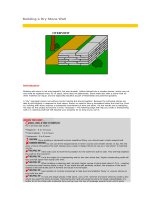Stone columns menard bachy
Bạn đang xem bản rút gọn của tài liệu. Xem và tải ngay bản đầy đủ của tài liệu tại đây (4.32 MB, 2 trang )
e?xe? Colonne Ballast GB.qxd:EXE fiche A4
2/11/09
16:44
Page 1
Stone Columns
Stone Columns
Advantages
• Stone Columns are designed to reduce
settlements of compressible soil layers in order
to be able to build most structures with shallow
footings and slab-on-grades on very soft soil;
• When applicable, their draining characteristics
result in an increase in the time rate of
consolidation settlement in soft cohesive soil;
• Because they are made of compacted granular
material, no curing period is necessary and no
cut-off to the shallow footing grades are required
as the excavation of the footing can immediately
follow the installation of the stone columns down
to the required elevation;
• High production rates;
• Stone Columns are also well-adapted to the
mitigation of liquefaction potential thanks to
the combined effect/advantage of their draining
potential and the increase of shear strength and
stiffness of the improved soils.
Applications
• Industrial warehouses and commercial buildings ;
• Condominium, apartment buildings, townhouses
and single-family residential developments;
• Reclaimed platforms (harbours, container terminals);
• Sewage treatment plants;
• Railway and roadway embankments;
• Retaining walls;
• Liquefaction mitigation and building support
in seismic areas.
Typical arrangement under structure and slab
Plan view
Under uniformly loaded structures such
as embankments and slabs-on-grade,
Stone Columns are installed on a regular
grid spacing. In this case, a load transfer
platform is designed and installed between
the top of the columns and the structure.
The Stone Columns installation results in
a significant reduction of the total and
differential settlements.
Stone Columns can also be installed as
a group to support isolated loads (shallow
spread footings) or directly under linear
loadings such as strip footing or retaining
walls. In this case, Stone Columns increase
the bearing capacity of the soil while
reducing the magnitude of settlement.
This technology is well suited for the
improvement of soft to very soft soils
(sillty sand, clays, silts, heterogeneous
fill…). However, when the surrounding
soils present a risk of long term
degradation of their geotechnical
characteristics (organic soils, very soft
clays, peat…) with very limited lateral
confinement, Stone Columns should not
be used for settlement reduction or
bearing capacity improvement.
Cross section
2, rue Gutenberg - BP 28 - 91620 NOZAY
Tel. : 33(1) 69 01 37 38 Fax : 33(1) 69 01 75 05
www.menard-web.com
Stone Columns are formed by inserting
a vibratory probe to incorporate granular
material into the ground and create vertical
inclusions with high stiffness, shear
strength and draining characteristics.
e?xe? Colonne Ballast GB.qxd:EXE fiche A4
2/11/09
16:44
Page 3
Stone Columns
Implementation and methods
Stone Columns are formed by inserting an hydraulic or electric vibroflot equipped
with a pressure chamber equipment (130 kW using air as a jetting fluid). This
combination gives
the best result for the incorporation of the granular backfill to the bottom of
the system and warrants the continuity and optimum compaction
of the columns.
Penetration of the probe assisted
by compressed air jetting
Backfilling and compaction of the granular backfill
1) Under combined effect of sustained
vibrations, its own weight and the
pull-down force, the vibratory probe
penetrates the soil down to the
prescribed depth or down to refusal.
During penetration, the soil is displaced laterally without any spoil
extraction.
2) As the probe is lifted, the ballast
material falls down by gravity in the
void that is created. The process is
facilitated by continuous injection of
compressed air. The aggregates are
inserted and compacted by extraction
and repenetration of the vibrating
probe through repeated incremental
lifts of 30 to 50 cm, each cycle being
repeated till the probe reaches the
surface.
Completed column
3) The diameter of the Stone Columns
depends on the properties of the
surrounding soil : in softer soils, the
compaction process results in higher
lateral expansion of the columns. Over
the length of the entire column, variable
diameter could thus be created due to
variable layers with different soil
conditions.
Off-shore Stone Columns
- Dunkirk Harbour (FRANCE).









